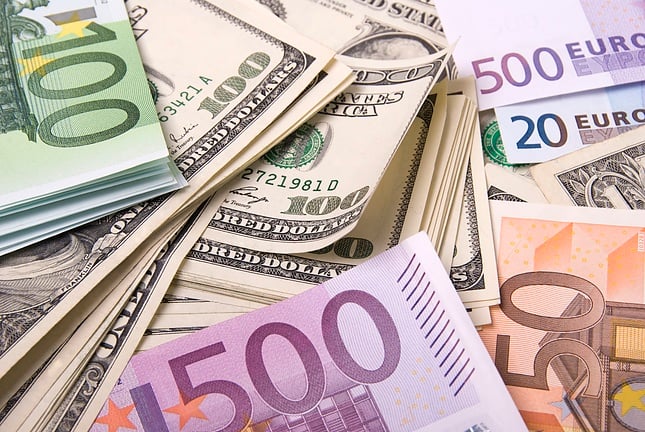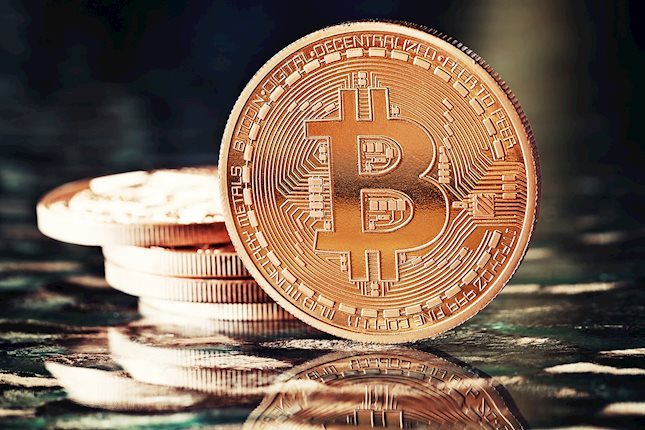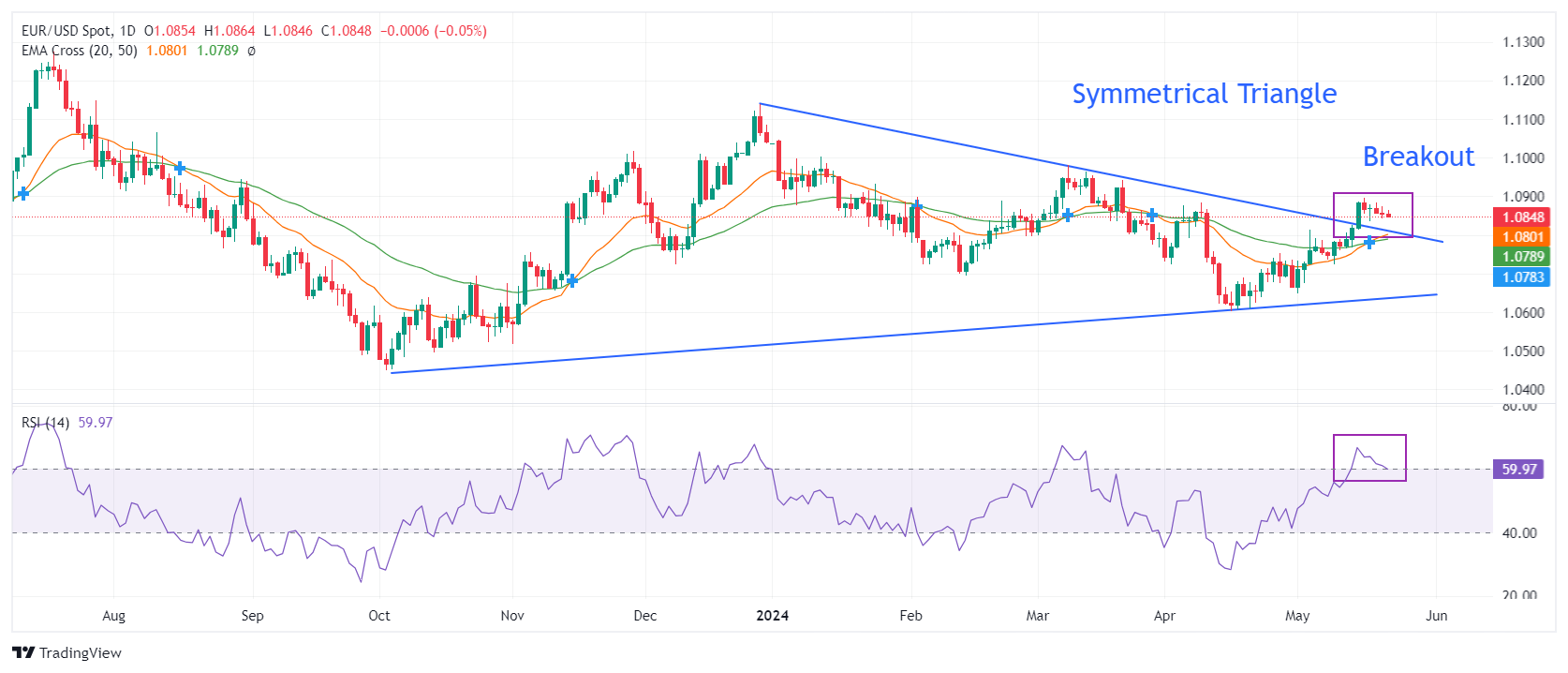- EUR/USD faces selling pressure as investors shift focus to the FOMC minutes.
- ECB policymakers are divided about continuing the dovish trend beyond the June meeting.
- Fed officials want to see inflation easing for months before lowering interest rates.
EUR/USD faces selling pressure and declines to 1.0820 in Wednesday’s New York session. The major currency pair trades cautiously ahead of the release of the Federal Open Market Committee (FOMC) minutes later in the day and the Eurozone/United States preliminary Purchasing Managers Index (PMI) data for May, which will be published on Thursday. The PMI data will provide cues about trends in demand, inflation and employment.
The Euro remains underpinned against the US Dollar as market participants doubt whether the European Central Bank (ECB) will extend the interest rate cuts beyond June. Few ECB policymakers, such as Bundesbank President Joachim Nagel, President of De Nederlandsche Bank Klaas Knot, Belgium Bank Governor Pierre Wunsch and Bank of Latvia Governor Martins Kazaks, believe that a rate-cut move in June is on the cards, but a follow-up move could be premature.
On the inflation outlook, ECB’s Nagel said, "There may well be months when inflation picks up a little, as some prices tend to fluctuate – energy prices in particular". Nagel added, "On the whole, I expect inflation to carry on declining towards our 2% target and to reach it in 2025."
Daily digest market movers: EUR/USD faces sell-off as US Dollar advances
- EUR/USD ticks down to 1.0840 as uncertainty over Federal Reserve (Fed) rate-cut timing has deepened. Fed officials support keeping interest rates at their current levels until they get evidence that inflation will sustainably return to the desired rate of 2%.
- The expected decline in the annual United States Consumer Price Index (CPI) data for April failed to build confidence among Fed policymakers that the progress in the disinflation process will continue. Given the strength of the US economy, officials are worried that the slowdown in price pressures will not last longer.
- On Tuesday, Cleveland Fed Bank President Loretta Mester said that she wants to see good inflation data for months in order to become comfortable with supporting a move to policy normalization. When asked about a concrete timeframe for rate cuts, Atlanta Federal Reserve President Raphael Bostic said he doesn’t expect them before the fourth quarter of this year. On the inflation outlook, Bostic commented that business owners have experienced a decline in pricing power but are confident about economic prospects.
- Going forward, investors will focus on the FOMC minutes of the May meeting, which will be published in Wednesday’s New York session. The impact of the FOMC minutes is expected to be light as Fed’s decision-making on interest rates was based on stubborn inflation data recorded in the January-March period.
Technical Analysis: EUR/USD falls to test Triangle breakout region near 1.0800
EUR/USD slips to 1.0840 as investors await the FOMC minutes release for fresh guidance. The major currency pair declines toward the breakout region of the Symmetrical Triangle around 1.0810, formed on a daily timeframe. The near-term outlook of the shared currency pair is still strong as the 20-day and 50-day Exponential Moving Averages (EMAs) have delivered a bullish crossover around 1.0780.
The 14-period Relative Strength Index (RSI) has shifted comfortably into the bullish range of 60.00-80.00, suggesting that the momentum has leaned toward the upside.
ECB FAQs
The European Central Bank (ECB) in Frankfurt, Germany, is the reserve bank for the Eurozone. The ECB sets interest rates and manages monetary policy for the region. The ECB primary mandate is to maintain price stability, which means keeping inflation at around 2%. Its primary tool for achieving this is by raising or lowering interest rates. Relatively high interest rates will usually result in a stronger Euro and vice versa. The ECB Governing Council makes monetary policy decisions at meetings held eight times a year. Decisions are made by heads of the Eurozone national banks and six permanent members, including the President of the ECB, Christine Lagarde.
In extreme situations, the European Central Bank can enact a policy tool called Quantitative Easing. QE is the process by which the ECB prints Euros and uses them to buy assets – usually government or corporate bonds – from banks and other financial institutions. QE usually results in a weaker Euro. QE is a last resort when simply lowering interest rates is unlikely to achieve the objective of price stability. The ECB used it during the Great Financial Crisis in 2009-11, in 2015 when inflation remained stubbornly low, as well as during the covid pandemic.
Quantitative tightening (QT) is the reverse of QE. It is undertaken after QE when an economic recovery is underway and inflation starts rising. Whilst in QE the European Central Bank (ECB) purchases government and corporate bonds from financial institutions to provide them with liquidity, in QT the ECB stops buying more bonds, and stops reinvesting the principal maturing on the bonds it already holds. It is usually positive (or bullish) for the Euro.
Information on these pages contains forward-looking statements that involve risks and uncertainties. Markets and instruments profiled on this page are for informational purposes only and should not in any way come across as a recommendation to buy or sell in these assets. You should do your own thorough research before making any investment decisions. FXStreet does not in any way guarantee that this information is free from mistakes, errors, or material misstatements. It also does not guarantee that this information is of a timely nature. Investing in Open Markets involves a great deal of risk, including the loss of all or a portion of your investment, as well as emotional distress. All risks, losses and costs associated with investing, including total loss of principal, are your responsibility. The views and opinions expressed in this article are those of the authors and do not necessarily reflect the official policy or position of FXStreet nor its advertisers. The author will not be held responsible for information that is found at the end of links posted on this page.
If not otherwise explicitly mentioned in the body of the article, at the time of writing, the author has no position in any stock mentioned in this article and no business relationship with any company mentioned. The author has not received compensation for writing this article, other than from FXStreet.
FXStreet and the author do not provide personalized recommendations. The author makes no representations as to the accuracy, completeness, or suitability of this information. FXStreet and the author will not be liable for any errors, omissions or any losses, injuries or damages arising from this information and its display or use. Errors and omissions excepted.
The author and FXStreet are not registered investment advisors and nothing in this article is intended to be investment advice.
Recommended content
Editors’ Picks

Australian Dollar stands soft as investors await local CPI data
The AUD/USD pair has been struggling to sustain its intraday gains, extending its losses for the second consecutive day and currently trading around 0.6460.

EUR/USD: Sellers will not leave it alone
EUR/USD resumed its widespread leg lower on Tuesday, rapidly setting aside Monday’s bullish price action and returning to the area below the 1.0500 support prior to key US data releases on Wednesday.

Gold under pressure below $2,630
Gold fluctuates above $2,600 on Tuesday after sliding almost three percent – a whopping $90 plus – on Monday due to rumors Israel and Hezbollah were on the verge of agreeing on a ceasefire. Whilst good news for Lebanon, this was not good news for Gold as it improved the outlook for geopolitical risk.

Bitcoin needs a further correction for sustained growth
After weeks of rapid growth, Bitcoin (BTC-USD) entered the maximum turbulence zone falling below $94,000. BTC is currently trading at $93,764 and continues to trend downward, having exited the ascending channel.

Eurozone PMI sounds the alarm about growth once more
The composite PMI dropped from 50 to 48.1, once more stressing growth concerns for the eurozone. Hard data has actually come in better than expected recently – so ahead of the December meeting, the ECB has to figure out whether this is the PMI crying wolf or whether it should take this signal seriously. We think it’s the latter.

Best Forex Brokers with Low Spreads
VERIFIED Low spreads are crucial for reducing trading costs. Explore top Forex brokers offering competitive spreads and high leverage. Compare options for EUR/USD, GBP/USD, USD/JPY, and Gold.
